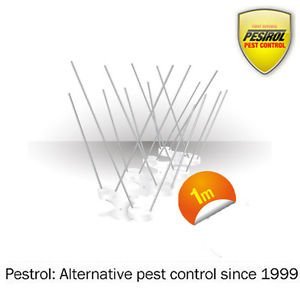How to Choose and Install Bird Spikes?
What are the Levels of bird infestation?
You may have realised by now that bugs are not the only pests around Australian urban and rural homes and businesses. Birds like pigeons set up home in gutters and leave behind ugly droppings that clog drains and gutters.
They also transmit human diseases like ornithosis. Starlings may be another problem pest in your area – they arrive in flocks and not only create a cacophony that destroys peace; they also leave behind guano that can play host to harmful fungi.
House sparrows are probably one of the biggest nuisances: they enter homes through tiny holes of warehouses and foul up or damage food stores.
Chemical treatment is available for bird pests, but those are not humane bird control options. You definitely don’t want to have to deal with dead birds – it’s just not right. So, why not just prevent the birds from settling in and around your home in the first place?
Spikes are great solutions for this. They point upwards and create an uneven surface that the birds find difficult to land on. They don’t hurt the birds – they simply drive them away to seek better locations to roost.

How to Choose and Install Bird Spikes?
Bird spikes are usually very precisely engineered to cleverly protect homes from birds in all situations. You can install them in areas where birds perch in the daytime and where they roost at night. No matter how wide the ledges of your building are, or how narrow a pipe that you want to ban sparrows from entering, you can find bird spikes to fit.
What are the Levels of bird infestation?
When selecting bird spikes, you should take into account the level of infestation that you’re experiencing. It helps to differentiate them as:
- Light pressure areas, where birds perch occasionally during the day
- Medium pressure areas, where birds perch habitually during the day
- Heavy pressure areas, where birds roost or nest at night
Dimensions: Once you’ve identified these different areas, you have to measure the dimensions of these areas. Consider questions like:
- How long the ledge is – this will help you decide how many spikes you will need
- How deep the ledge is – to help you choose the model of spikes
You will also need to think about the size of the birds that you want to keep out. If they’re small like pigeons, you may need narrower spikes that the birds can’t get through. If they’re a larger species, large spikes will suffice. Also consider any windows, barriers overhead and other features that can limit the space that the spikes can take up.
Material: The material your spikes are made of is also important. Spikes that are made of stainless steel have a high tensile strength: they can’t be pushed out of the way or bent out of shape by the birds. Spikes with polycarbonate bases last really long because they are protected from natural cracking and breaking caused by UV rays.
Aesthetics: You may be bothered about your home looking like a high security detention centre with spikes all over the ledges. That is usually not a problem with good quality bird spikes.
Finally, to make sure that the spikes adhere well, you should clean your ledges and gutters well before the installation. This will make sure the adhesive does its work as it’s supposed to do.
Check out our range of Pestrol bird spikes.
Let us know if you have any questions. срочный займ на карту сбербанказайм онлайн москвазайм онлайн 24 часа



